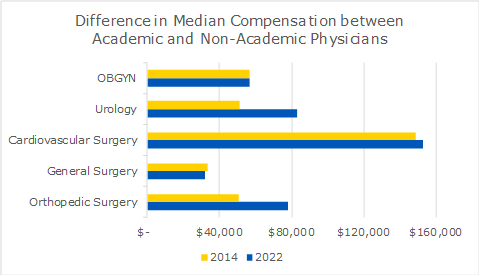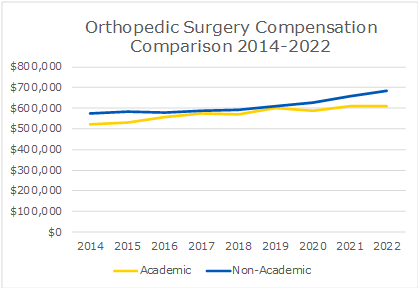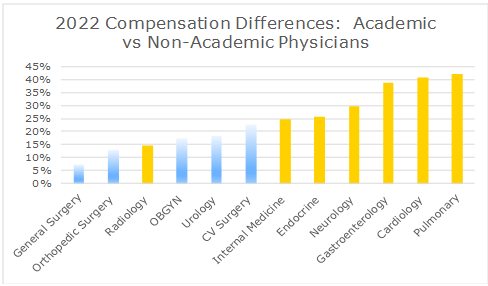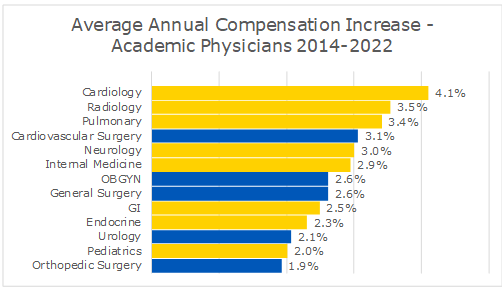Are There Physician Compensation Gaps Between Academic and Community Physicians?
The Surgical Specialties (Part 2)
Part 1 of this blog revealed that the increased blending of academic medical center and non-academic providers in the same health systems has led to compensation increases in the academic setting that outpaced those in the non-academic setting, for non-surgical specialties. We found the size of the difference in compensation between academic and community non-surgical specialists was still material but not decreasing as much as we expected.
(See Part 1 for non-surgical specialty compensation figures).
Compensation increases in the academic setting for medical specialists are clearly a result of competition to recruit and retain AMC physicians, as well as the competition between AMCs and their non-academic counterparts.
We found that differences in compensation between academic and community physicians have historically been and continue to be smaller in surgical specialties than non-surgical specialties, and that compensation gaps in some surgical specialties are growing.
For example, for example, in 2014, AAMC reported median compensation of $382,000 for general urology associate professors[1], compared with AMGA reported median compensation of $433,000 for a urologist (a gap of $51,000, with non-academic compensation 13% higher). By 2022 the gap had increased modestly to $81,000 (19% higher). The increased difference in compensation was due to a lower increase in average annual academic compensation (2.1 percent per year) than for non-academic compensation (2.6 percent).
Exhibit 1 shows the change in compensation for the five surgical specialties between 2014 and 2022.
Exhibit 1
Source: Veralon analysis of 2014-2022 median compensation market data. Academic data from American Association of Medical Colleges (AAMC) and non-academic data form American Medical Group Association (AGMA).
The compensation differences in the surgical specialties are generally smaller than the differences in the medical specialties and unlike the differences in the medical specialties, are either stable or increasing.
In orthopedic surgery, for example, the gap between compensation reported by academic institutions and non-academic physicians’ clinician market data, has been relatively consistent over the last eight years. The compensation gap appears to be widening slightly but this data suggests a competitive recruitment environment for orthopedic surgeons and that AMCs have been willing to pay more for high margin specialists.
Exhibit 2
Source: Veralon analysis of 2014-2022 median compensation market data. Academic data from American Association of Medical Colleges (AAMC) and non-academic data form American Medical Group Association (AGMA).
Considering the Implications
In general, conventional wisdom has been that physicians working in academic medicine earn less than their counterparts working in a community-based setting since academic physicians have non-clinical duties, such as teaching and research, and spend less time on revenue generating activities. However, as we’ve seen, this varies significantly by specialty. We analyzed data for 13 specialties (8 medical and 5 surgical) and found on average the compensation difference (at the median) between academic and community physicians was 23 percent). However, the difference ranged from a low of 7 percent in general surgery to a high of 42 percent in pulmonary medicine.
Exhibit 3 confirms that across the board, AMC-based surgeons do better in comparison with community-based surgeons than their non-surgical peers.
Exhibit 3
Source: Veralon analysis of 2014-2022 median compensation market data. Academic data from American Association of Medical Colleges (AAMC) and non-academic data form American Medical Group Association (AGMA).
In general, where there are larger differences (cardiology, pulmonary, neurology) compensation increases on the AMC side have been higher than in specialties with smaller differences. On the contrary, where there are smaller differences (orthopedic surgery, general surgery OB) compensation increases are on the lower end. AMCs appear to be playing catchup in many areas.
Exhibit 4
Source: Veralon analysis of 2014-2022 median compensation market data. Academic data from American Association of Medical Colleges (AAMC) and non-academic data form American Medical Group Association (AGMA).
Historically, academic medical centers and community hospitals drew from different labor pools due to differences in the nature of the work, employment structures, compensation differences and the professional priorities of the physicians.
As AMCs join blended systems, faculty will likely become increasingly aware of how their compensation differs from those of their non-academic peers. Leadership needs to be prepared to address questions of internal equity, the potential for increased compensation demands, and greater costs for compensation, particularly for medical specialists.
[1] We opted to utilize market data for Associate Professors as a proxy for compensation for academic physicians as the Associate Professor rank is between Assistant Professor and Full Professor ranks.



